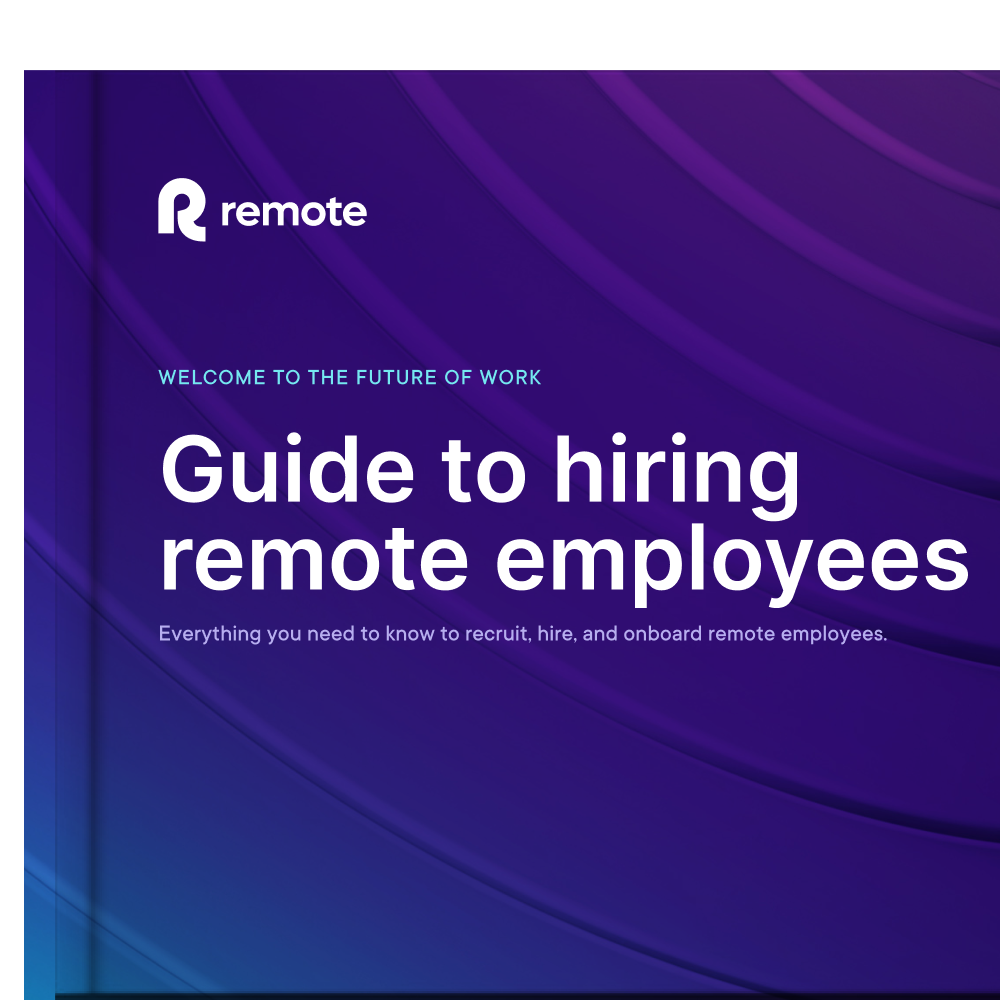
Product Updates — 7 min

Employer of Record & PEO — 16 min
Remote hiring comes with a world of opportunities. Tapping into a global talent pool, increased diversity, lower office rental costs — the list goes on. Businesses today have realized this incredible opportunity. In fact, it’s estimated that 32.6 million Americans will work remotely over the next couple of years.
Having a flexible, diverse team is appealing, but getting to this point doesn’t happen overnight. From communication barriers to international employment laws, the challenges are real.
This remote hiring guide breaks the process into manageable steps, giving you the insights you need to confidently hire employees from anywhere in the world.
The shift to remote work saw a significant rise during the pandemic, with the number of Americans working from home more than tripling between 2019 and 2021. And while there’s been a gradual decrease since then, remote work is still very much a part of work culture today.
Although some companies are advocating for a return to the traditional office setup, research shows that remote work is here to stay. Businesses around the world have witnessed firsthand the advantages remote work brings and are unlikely to go back to a purely in-office work model.
According to a FlexJobs report, remote work has grown 159% globally over the past 20 years. This trend will continue to increase, with projections that 73% of all teams will have remote workers in just a few years.
German conglomerate Siemens switched to a permanent flexible work arrangement, allowing thousands of its employees to work remotely.
“We’ve always had mobile working at Siemens, but now we’re taking it a step further,” said Roland Busch, Deputy CEO and Labor Director of Siemens AG, at the time. ”These changes will also be associated with a different leadership style, one that focuses on outcomes rather than on time spent at the office.”
The idea that results are more important than time spent at a specific desk in a particular building is one of the benefits of remote work. Rather than managing the time workers spend at their desks, supervisors can instead manage their output, trusting employees to get the work done on their own.
Freedom from offices means freedom from offices everywhere, though. Hiring a remote team gives organizations the ability to reach across the globe and handpick the best talent for their open positions. When the office doesn’t exist, why limit your talent pool to local candidates alone?
Here are some of the key advantages for businesses that embrace remote hiring:
Traditionally, companies have been limited by geography when filling open positions.
Organizations have had to hire people who live near their facilities, or else hope their jobs were enticing enough to convince great candidates to move. In 2022, 1.91 million people in the US moved to be closer to a new job, according to the US Census Bureau.
However, hiring remotely expands your talent pool from your immediate area to, well, every area. No matter where the best candidates live, they can now work for you.
The old approach is limiting in more than one way, too, with local recruitment restricting opportunities for diversity. Remote work is intentionally inclusive, allowing organizations to recruit diverse candidates proactively from around the world.
Remote hiring creates more opportunities for people who may face challenges in their careers, like those from working-class backgrounds or who have disabilities. Working remotely gives them the flexibility to work in environments that accommodate their needs without having to commute. Workers with disabilities have long faced struggles with traditional workplaces, for instance, and have fought for accommodations that allow them to work from home.
Remote-first workplaces are an important step in making well-paying work more accessible to those who might be excluded by the limitations of an office, including parents and caretakers who often worry about taking time off for family obligations.
It's no wonder, then, that remote and flexible work arrangements are seen as a perk by employees. Research shows that 83% of workers around the world would turn down a job that didn’t offer flexible working. And over half of employees say that having a choice of work location is more important to them than working for a prestigious company.
With this in mind, hiring remotely provides an immediate and obvious boost to employee satisfaction and retention. 54% of businesses have seen higher employee retention because of remote work. But this is not without challenges.
Hiring remotely can be easy, but transitioning to a workplace that welcomes remote workers takes some effort. International borders still matter when you’re handling payroll in multiple countries, trying to abide by multiple sets of employment laws, and dealing with taxes.
Each of the following aspects of hiring international employees can add layers of complexity — especially if this is your first remote hiring experience.
Payroll can be a headache in the simplest of circumstances, but even more so for small businesses with limited accounting resources. When you hire internationally in new locations, trying to handle payroll yourself without running afoul of local laws can be a complex task.
Whether you plan to open an entity abroad or not, outsourcing your global HR and payroll management to a global employment partner is the smart play.
Should you pay a remote worker the same rate you would pay a local one? What is fair in their country? What is the cost of living there? What benefits do they expect? What is considered to be competitive pay? While you do have a few options when calculating compensation for remote employees, finding your own balance can still be tricky.
What about the taxes you pay for doing business in a country? “Permanent establishment” is a tax term for businesses that have an ongoing presence in a country. If permanent establishment applies to your country, you might be subject to corporate taxes abroad. You might also have to meet other standards of compliance that other international companies do not. You can learn more about permanent establishment in our in-depth guide.
There are significant dangers to misclassifying your employees as contractors, whether it's intentional or not. You could be subject to fines, penalties, and business bans under various local laws, as well as legal disputes with your employees.
Be cautious when defining job roles. What exactly will your team members do? What is their relationship to your company? Do you already have contractors in other countries? You may also need to consider converting some contractors to employees (which is another potentially tricky situation).
Traditional office setups make intellectual property rights a bit more straightforward, if only because offices only exist in one country at a time. International hires complicate that somewhat.
Remote employees don’t always work in a company building, on company equipment, or on company time. Losing your IP rights because you’re not aware of international law can cause several problems, such as legal battles and reputational damage. To learn more, check out our in-depth guide on intellectual property rights for remote teams.
If you’re based in one country and your team is located all over the world, how do you figure out income taxes? Do they pay taxes where they live, or where your business is based?
The good news is that taxes for remote workers are not much more complicated than those for traditional office workers. The bad news is that most educational resources on taxation cater to people in traditional environments. It’s important to know where remote workers pay taxes so you, and they, can remain compliant.
Fortunately, all of the above issues — intimidating though they might seem — are manageable. What you need is an expert partner who specializes in local employment law, and can guide you through recruitment, managing risk, and scaling effectively.
In many ways, the hiring process for remote, international employees is much the same as the hiring process for traditional, on-premise workers. That said, throughout the hiring and onboarding process, you should focus on how the job will be done remotely.
You need a clear job description and a solid understanding of how that job will be done remotely, as well as what tools and qualities potential job candidates will need. Before you start the process, be aware of where your job posting will be seen and what benefits and pay are expected by the people who will see it.
Know ahead of time how you will be conducting your interview and what technology you’ll be using. At this point, most people are well-versed in standard videoconferencing technology, but it’s important to choose a technology that can be easily accessed by all parties.
Good communication is critical to remote teams, and that starts right at the beginning.
Be clear about your expectations of applicants, talk to them and their references about their past experience, and understand that qualifications often change from country to country. Be clear about what the expectations of the job are, how you plan to work with your remote team, and what you’ll require of them.
Your candidates may feel they’re taking a risk by taking a job with a remote and international employer, so make sure you’ve done your homework and can answer their questions. If you don’t have the answer for something, be honest about it and get back to them as soon as possible once you have an answer.
When you’re working across time zones and borders, it’s important that everyone is on the same page when it comes to onboarding. This has to do with having a solid training program in place and with the legal paperwork that comes along with hiring an employee. This step is where you’ll likely need help.
Learn the processes you need to find, recruit, and onboard remote employees (and stay compliant while you're at it).

Unless you're an established multinational with huge resources, you’re likely going to need help from a global HR partner to handle payroll, compliance, taxes, and other administrative tasks. It’s easy to run afoul of international requirements and obligations if you’re not an expert, and penalties can be stiff.
As a result, it’s crucial to partner with an organization that can manage these pieces of the puzzle. However, providers don’t all work in the same way, and the best course of action depends on your circumstances and your goals.
If you already own a legal entity abroad, it might make more sense to work with a professional employer organization (PEO) for that country. A PEO acts as a sort of outsourced HR department, managing your global payroll and other HR-related tasks.
If you're planning to hire in multiple countries, though, then an employer of record (EOR) might be more appropriate. An EOR legally employs workers in other countries on your behalf. You handle all the day-to-day management of your employee, but on the paperwork, the EOR is technically the employer. This allows you to employ people legally in other countries (through the EORs entities).
To learn more about the differences between an EOR and a PEO, check out our in-depth guide.
It's important to note that there are two kinds of global employment solutions providers. Some own legal entities in the countries where they operate, while others rely on partner networks. So what's the difference?
An owned-entity provider owns the legal entity in the country you’re hiring in. They’re already compliant with local laws, and ready to handle everything in-house, from taxes and payroll to HR management and IP protection.
Conversely, partner-reliant providers operate through third-party companies. While they may be able to provide more services in the short term, there’s more risk involved, response times are usually slower, and there are extra (often hidden) costs that are invariably passed on to you. If you have a problem, there may also be more than one point of contact.
Third parties can be risky. Owned entities are quicker to be compliant with local laws and don’t outsource your HR and IP needs to a company you don’t know.
If you’re ready to expand into new countries, Remote simplifies your HR processes, making global growth seamless. With Remote, you can accelerate international expansion in days, gaining the crucial edge needed to compete in global markets.
From recruitment and contracts to payroll, tax, and compliance, Remote manages it all—allowing you to focus on securing top talent to scale your company across borders.
Creating a remote workplace is about more than simply hiring some workers online.
While hybrid work models provide a good short-term basis to grow your international hiring, you must ensure that your remote and globally distributed teams feel as connected, aligned, and valued as your in-office employees. In the long term, hybrid models can leave people feeling disconnected, overworked, and ineffective due to the mistakes companies often make when they start going remote.
As a result, you risk ostracizing your remote employees — unless you consciously build a remote-first culture. As big a perk as remote work is, feeling left out of onsite bonding activities or perks — like after-work drinks, lunches, or meetings scheduled in person — isn’t good for your wider company culture.
Clear communication is also critical when working with a remote team. It can be easy to misconstrue digital communication, especially if you’re working across language or cultural boundaries. The best remote teams document everything. People work at different times and need to understand exactly what happened while they were sleeping.
Making sure that you’re anticipating the needs of your remote workforce goes a long way toward aligning your teams, creating a welcoming work environment for all, and retaining the workers you've hired from all over the world. To learn more about communication in remote teams, check out what our CTO, Marcelo Lebre, says about asynchronous working.
Another thing to consider is how you’ll scale your international employment. You may start with one employee in one country, then find more talent in the area and want to scale.
This is why it's important to choose tools that will grow with your business. In building a remote-first culture, that culture will have to scale too.
Growing a culture takes strategy, and requires a conscious decision to base your team around remote-first values. This means taking a proactive approach to fostering diversity and hiring inclusively. You must also decide what your company values and how your team members should embody those values. No matter whether you are hiring remote designers, marketers, salespeople, or developers — your values must remain consistent and essential.
Be intentional about creating your global team and don’t silo employees in territories. Encourage people to meet one another in meetings, in productivity platforms, and while working on projects. Not everyone’s work hours will be the same, but everyone should feel they’re working together. If your budget allows it, in-person gatherings can also become a great way to foster team spirit.
Employees who reach outside of silos tend to achieve more. So, don’t make your employees reach — keep them as unsiloed as possible so they can collaborate.
Culture builds every time you make a hire, whether you realize it or not. Your onboarding program should clearly communicate your remote-first work practices and make it easy for your new hires to start collaborating without stress.
Onboarding is your new hire’s first experience with your organization, so use this time to introduce them to your company and your culture. Reinforce communication guidelines by explaining the sort of communication you expect, and demonstrating it yourself.
Asynchronous communication thrives on fewer meetings and well-organized documentation, so you should have plenty of available media for your new people to consume.
Consider assigning your new employee a buddy in their time zone, too, so they feel included and know where to turn when they have questions.
Hiring your first remote employees — especially those who live outside of your country — can be intimidating. Of course, you’re worried about risk. Of course, it’s hard to know where to start. And of course, compliance, taxes, and costs are all daunting questions. But making that first international hire isn’t just possible: with Remote, it’s quick and easy.
We provide dedicated global payroll and global HRIS services, allowing you to easily manage your people across the globe. We also offer EOR services, enabling you to focus on expansion without worrying about administration and compliance issues.
For the best intellectual property protection, the best experience for your international employees, and the most reliable partner for your global expansion, we’re here and ready to help.
Remote has been instrumental in helping TheyDo, a globally distributed company, overcome the challenges of global recruitment.
By streamlining hiring processes and providing expert guidance on local labor laws, Remote enables TheyDo to tap into a limitless talent pool without compliance risks. Remote offers simple onboarding and payroll, allowing TheyDo to recruit top-tier candidates with speed and precision. This partnership empowers TheyDo to scale efficiently while focusing on innovation and building a world-class team.
“Remote helps us unlock unlimited talent pools, and having the best talent gives us the greatest chance of business success. They enable us to onboard quickly and seamlessly, providing specialist knowledge on local labor laws. This combination of expertise, speed, and quality creates a win-win situation for both the candidate—our new hire—and for TheyDo.” Matt Moralo Langan, Head of People
Want to check out Remote in action? Book a demo to see how using Remote can lead to a 30% reduction in time-to-hire.
Create an account with G2's top-ranked multi-country payroll software and start onboarding your first employees in minutes.

Subscribe to receive the latest
Remote blog posts and updates in your inbox.

Product Updates — 7 min

Global Payroll — 2 min

Minimum Wage & Compensation — 7 min

Newsroom — 5 min